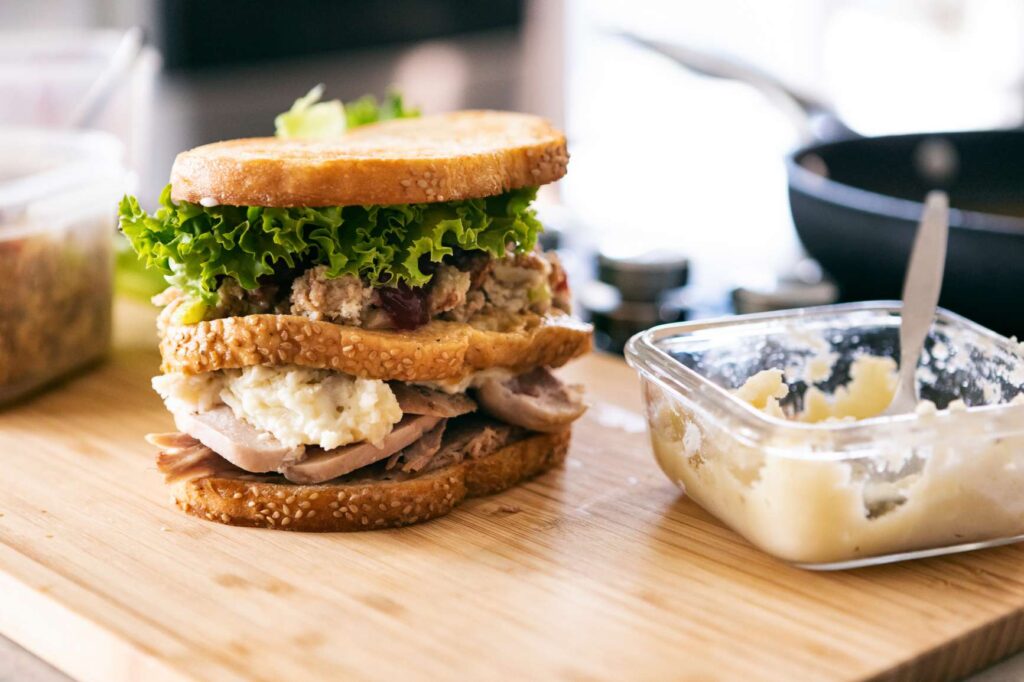:max_bytes(150000):strip_icc():format(jpeg)/Health-Stocksy-5047075-b26eacf309c74cc2a920e1c71784a4f3.jpg)
Thanksgiving Day is over and the race is on—not to score the best deals on Black Friday, but to eat the copious amounts of turkey, mashed potatoes, and pie before they go bad.
Practicing proper food storage in the days leading up to Turkey Day and cooking the meal with food safety in mind are two ways to help avoid any digestive woes—but safe food practices don’t end when the meal does.
According to the Department of Health and Human Services, leftovers should be put away within two hours of cooking, and eaten within three to four days of being refrigerated.
But these are very general guidelines—read on to know exactly how to store and reheat leftovers, and how long you can safely eat turkey and sides, according to food safety experts.
Even with proper food storage, you can only eat Thanksgiving leftovers for so long.
“Leftovers from the refrigerator should be eaten within three to four days,” Wade Syers, DSocSci, extension specialist for food safety at Michigan State University, told Health.
Freezing leftovers can make them last a bit longer—they keep for as many as three to four months, but not all foods freeze well.
“Some foods freeze better than others,” said Syers. “While a pumpkin pie can last one to two months in the freezer, cooked turkey or meat can last from two to six months in the freezer.” Syers added that he wouldn’t recommend freezing salads, custards, food with milk sauces, or homemade eggnog.
Reheating those refrigerated or frozen foods matters too—it’s also best to do that in smaller portions.
“For both hot foods and cold foods, I recommend placing small amounts on the table or serving counter, while leaving the rest […] in the refrigerator,” Darin Detwiler, PhD, an associate professor of food safety at Northeastern University, told Health.
When reheating refrigerated leftovers, you want the food to come back up to a safe temperature before eating. All leftovers should reach an internal temperature of 165 degrees; and sauces, soups, and gravies should come to a rolling boil while reheating.
And regarding desserts, those that may be stored at room temperature should be tossed after a few days, while refrigerated desserts are likely safe for up to a week, said Syers.
As soon as your Thanksgiving meal comes out of the oven (or refrigerator) and onto the table, the timer starts: That’s because bacteria can grow rapidly at temperatures between 40 and 140 degrees Fahrenheit (a.k.a., the “danger zone”).
Hot or cold foods at room temperature should be left out no longer than two hours—that number goes down to one hour when the temperature is over 90 degrees. If food has been left out for more than two hours, it’s best to throw it away.
But refrigeration isn’t the only step—food must cool quickly to prevent bacterial growth, so dividing larger portions of food into smaller pieces or containers is important, as is sealing those containers.
“If you put large batches of food in large containers in the fridge without breaking them into smaller containers, the food in the center of the pot or dish may not cool quickly enough and allow for bacteria to grow,” Ellen Shumaker, PhD, director of outreach for the Safe Plates program at North Carolina State University, told Health.
The shallower the container, the better: “Shallow containers with a product depth of less than 2 inches allow the heat from food to disperse faster than deep containers,” according to Carla L. Schwan, PhD, assistant professor and extension food safety specialist at the University of Georgia.
The temperature of your refrigerator matters too—the U.S. Department of Agriculture (USDA) recommends a safe refrigerator storage temperature of 40 degrees or below.
It can sometimes be tricky to know how to store pie and other Thanksgiving desserts.
“With apple pie, for example, the high sugar content and acidity of the apples will slow the growth of potentially harmful bacteria, so it can safely be kept at room temperature,” said Shumaker. “However, if using sugar substitutes, the pie should be refrigerated for quality reasons.”
Storing pumpkin pie also isn’t cut-and-dry: “It depends on whether it was store-bought or homemade,” said Shumaker.
“Store-bought pies are cooked at a [certain] time [and] temperature and often contain preservatives that will prevent bacterial growth,” added Shumaker. “Unless the package says otherwise, it is not risky to keep these out on the counter.” Homemade pumpkin pie, however, should be stored in the refrigerator.
Baked goods like breads and cookies can be stored at room temperature, but it’s a good idea to cover them to prevent contamination, said Shumaker. And, if your baked goods have cream, custard, cheese, or meat, she said they should be refrigerated.
Food doesn’t have to look or smell off to make you sick—foodborne illness is the biggest risk in eating food that hasn’t been stored properly, or leftovers you’ve kept around for too long.
According to Schawn, you can become infected with any of the following bacteria: Salmonella, Escherichia coli, Listeria, and Bacillus cereus. Those infections most commonly cause digestive woes, like nausea, vomiting, diarrhea, and fever, but they can also lead to more serious complications.
Food poisoning isn’t a rare thing: Every year in the U.S., 48 million people get sick from a foodborne illness, 128,000 are hospitalized, and 3,000 die—and everyone is at risk.
“Everyone can become sick from a foodborne pathogen,” said Detwiler. “The most vulnerable populations—the very young, the elderly, those with a compromised immune system, and those who are pregnant—are the ones most likely to become hospitalized and even die.”
The good news: Food poisoning is largely preventable with proper preparation, food storage, and reheating—and proper food safety is especially important around the holidays while entertaining family and friends.
“While this is rarely something that people ask for [during the holidays],” said Detwiler, “nobody wants a family holiday gathering to be remembered for all the wrong reasons.”













